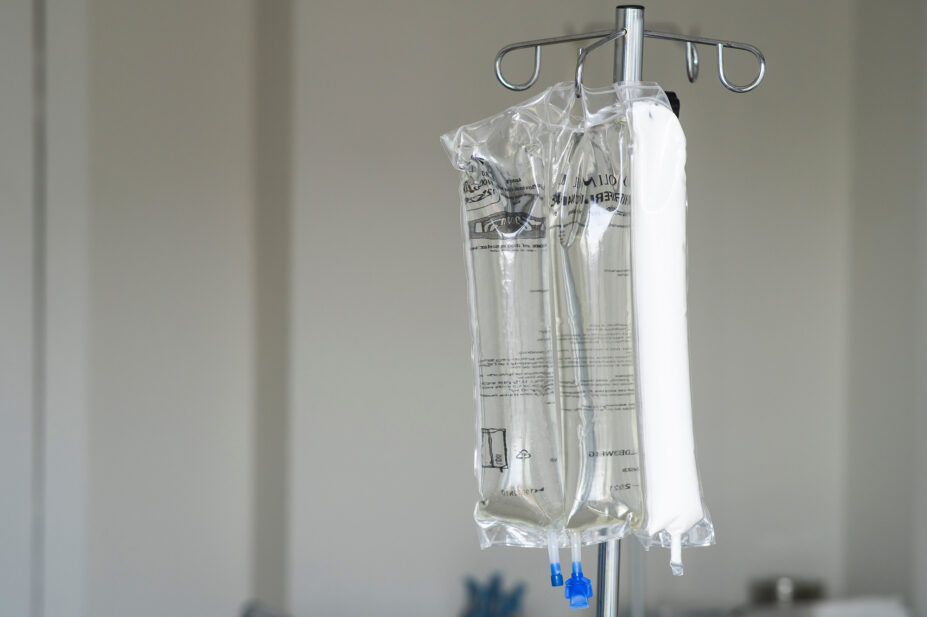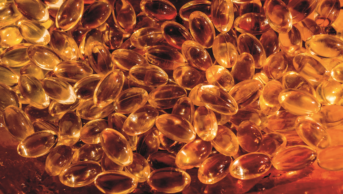
Shutterstock.com
After reading this article, you should be able to:
- Know the indications for parenteral nutrition (PN);
- Identify the risks and benefits of PN;
- Understand how regimens are formulated for patients;
- Understand monitoring and considerations for medicines management for patients that are on PN.
Introduction
Parenteral nutrition (PN) is a vital and complex therapy that requires specialised clinical knowledge, skills and experience to ensure safe prescribing, management and compounding (i.e. a specialised process of preparing PN under strict aseptic technique). PN delivers nutrients directly into the bloodstream through an intravenous (IV) route, bypassing the gastrointestinal (GI) tract, and is used for patients with intestinal failure (IF). IF is defined as a reduction in intestinal absorption that — without treatment or compensatory mechanisms — leads to malnutrition and/or dehydration1. It results from obstruction, abnormal motility, major surgical resection, congenital defect or disease-associated loss of absorption2.
IF is classified into types 1, 2, and 3, which are based on its onset, metabolic characteristics and expected outcomes. Each classification considers the anticipated duration of nutrition support and the possibility of reversing the underlying condition1. For more information on the classifications of IF, see Table 11.
In England, it is currently estimated that 600–700 patients with type 2 IF receive care from a nutrition support team (NST) each year2. The incidence of type 2 IF has been rising over the past decade and is expected to continue increasing, potentially reaching 1,000 patients annually within the next decade2. It is thought that this increase is owing to the complexity of the operations being performed and post-operative complications. The prevalence of type 3 patients requiring long-term home PN has been growing at a rate of 20% per year. It is projected that within the next five years, the prevalence of home PN will increase to 80 patients per million, up from the current 50 patients per million2. It is difficult to estimate how many type 1 IF patients receive PN per year, owing to a lack of available data and differences in management between hospitals.
To ensure safe, effective and cost-efficient care for patients with IF, a specialist NST, which includes clinicians (i.e. surgeons and physicians), dietitians, pharmacists and nurses, is essential. Pharmacists with specialised expertise are crucial for the effective management of PN patients. Their responsibilities include providing sterile PN, optimising nutrient composition, advising on compatibility and stability issues and managing drug-nutrient interactions.
This article will provide an overview for pharmacists on the indications for PN, the risks and benefits, as well as other considerations for the care of adult patients with IF.
Indications of PN
The National Institute for Health and Care Excellence (NICE) recommends that PN should be considered in patients who are malnourished or at risk of malnutrition and meet either of the following criteria:
- Inadequate or unsafe oral and/or enteral nutritional intake;
- A non-functional, inaccessible or perforated (i.e. leaking) GI tract3.
Those who are malnourished are defined as:
- Having a BMI of less than 18.5 kg/m2;
- Having unintentional weight loss greater than 10% within the past three to six months;
- Having a BMI of less than 20 kg/m2 and unintentional weight loss greater than 5% within the past three to six months3.
Patients are at risk of malnutrition when:
- They have eaten little or nothing for more than five days and/or are likely to eat little or nothing for the next five days or longer;
- They have poor absorptive capacity, and/or have high nutrient losses and/or have increased nutritional needs from causes such as catabolism3.
For an overview of conditions and GI characteristics that can result in the need for PN, see Table 24.
PN should only be administered after oral or enteral nutrition has been assessed and deemed either inappropriate or impractical5. However, there are instances where both oral/enteral and PN are required simultaneously. For example, when a patient has short bowel with some absorptive capacity, they may be able to eat and drink but be on PN simultaneously as supplementary nutrition5.
Risk and benefits
The primary benefit of PN is that it supports patients with impaired bowel absorption, allowing them to maintain normal nutrition and hydration, which they would otherwise be unable to do4. However, it also carries significant risks, which can be categorised into insertion-related, line-related and metabolic complications. Metabolic complications are further divided into acute, which are associated with short-term PN, and chronic, which are associated with long-term PN6. For an overview of the complications of PN, see Table 36.
Nutritional requirements and feeding regimens
As discussed in the report, ‘Parenteral Nutrition: A Mixed Bag’, published in 2010, if PN is deemed a clinical necessity, this should be rapidly actioned and PN started at the earliest opportunity5.
Determining nutritional requirements
PN consists of macronutrients, such as carbohydrates, lipids and amino acids, and micronutrients, including electrolytes, vitamins and trace elements, and water7.
Nutritional requirements should be determined by healthcare professionals with the relevant skills and training in the prescription of nutrition support — this includes doctors, pharmacist, dietitians and nurses all trained in the relevant field5.
A ‘Pocket guide to clinical nutrition’, published by the British Dietetic Association’s parenteral and enteral nutrition specialist group (PENG) in 2018, outlines a step-by-step process for estimating the nutritional needs of adults, considering factors such as weight, BMI, age and clinical condition. These estimates serve as a starting point, and the application of clinical judgment and ongoing monitoring are crucial for proper care8. For an example of an energy expenditure calculation, see Box 18.
Box 1: Example of an energy expenditure calculation
A 35-year-old female with pancreatitis, who weighs 52.4 kg, BMI <30
PENG requirements;
Energy requirements: 25kcal/kg × PAL* (1.2-1.4) = 1572-1834kcal
Protein requirements: 1-1.5g/kg = 53-78g
Nitrogen requirements: 8.5-12.5g
*physical activity level
Fluid and electrolytes
A diagram produced by NICE, which details ongoing fluid and electrolyte losses and offers a valuable reference for understanding insensible fluid losses in patients, can be seen here. This is crucial when evaluating a patient’s fluid balance and determining their specific fluid and electrolyte requirements9.
Fluid and electrolyte requirements can vary significantly for patients on PN. A patient’s baseline fluid needs are typically 25–35 mL/kg/day; however, factors such as oral intake, excessive losses and other medical conditions, such as heart failure, renal failure and oedema, must also be considered when estimating total fluid requirements. These factors will similarly influence the variation in electrolyte needs9.
It is important to consider a patient’s intake of fluid, electrolytes and calories from other sources, such as medications or additional IV fluids. The volume and electrolytes present in certain medications — for example, IV antibiotics that are made up in sodium chloride 0.19% or sodium chloride 0.18% & glucose 4% — must be accounted for. If a patient is receiving total PN, it is highly likely that all their medications will be administered intravenously9. To be given an IV, most medications are typically prepared in either glucose or 0.9% sodium chloride, so these should also be factored into the calculation of the patient’s fluid and electrolyte requirements9.
Initiating PN
Following a nutritional assessment, a patient’s PN regimen will then be carefully planned. The specific regimen chosen largely depends on the type of PN that the hospital is equipped to provide. Some hospitals may only be able to outsource PN production, often through contracts with specific providers, which can limit the range of PN available for use. In contrast, other hospitals have the capacity to prepare a wide variety of PN in-house within their aseptic units. Several factors influence this process, including the presence of a NST, framework agreements, tenders and aseptic capacity.
PN solutions available include multi-chamber bags (MCBs), sometimes known as all-in-one bags, and ‘bespoke’ compounded PN bags. MCBs contain all the required nutritional components (e.g. carbohydrate, amino acids, +/- lipid, water and +/- electrolytes) in physically separated compartments and are mixed just before administration by rolling the bag. Prior to rolling, MCBs have longer shelf lives and do not need refrigeration1,2,7. ‘Bespoke’ PN bags are prepared using the individual components to achieve an exact ‘recipe’ that is required. These need to be refrigerated and have a shelf life of up to 28 days. Under controlled aseptic pharmaceutical conditions, vitamins, trace elements and electrolytes may be added to both types of bags, provided stability is obtained. A large proportion of MCBs are commercially available with the addition of vitamins and trace elements, requiring no manipulation in a hospital aseptics unit, which can be purchased by individual hospitals1,2,7.
The initiation of PN requires collaborative input from all multidisciplinary team members. Each discipline contributes a unique perspective, allowing for the development of shared, patient-centred goals. This multidisciplinary approach ensures that all aspects of care — nutritional, medical, pharmacological and psychosocial — are optimised for best outcomes.
Before initiating PN, it is crucial to assess the patient’s allergies and allergy history. The lipid source in PN may contain oils and lecithin derived from soybean, egg, fish and olives. As a result, it is important to review the summary of product characteristics (SPC) of the specific lipid source to ensure it does not contain any allergens to which the patient is allergic1,2,7.
All PN (MCBs and bespoke PN) should be protected from light during storage and throughout administration. The PN must be administered through an in-line 1.2µm filter1,4,10.
The type of regimen prepared and administered depends on the patient’s venous access. PN can be delivered through peripheral or central veins, with central vein administration being the preferred method. This is because hyperosmotic solutions are poorly tolerated by peripheral veins and can cause pain, thrombophlebitis and thrombosis1–3. Factors that influence the osmolarity of PN solutions include glucose concentrations and electrolyte additions. Generally, solutions with an osmolarity of less than 900 mOsm/L are considered safe for peripheral vein administration1–3.
Additionally, when administering PN peripherally, the rate and concentration of potassium must be carefully considered, with the maximum administration rate not exceeding 20 mmol/hour and the concentration not exceeding 40 mmol/L. IV potassium is an irritant and rapid administration can be harmful. If rates exceeding 20mmol/hour and concentrations more than 40mmol/L are required, then continuous ECG monitoring must be performed, owing to the risk of serious arrhythmias or cardiac arrest11,12.
If a patient with chronic IF continues receiving PN after being discharged from the hospital, their nutritional requirements will change. Protein and energy needs are individualised based on their intestinal absorption capacity and specific needs, and these needs are closely monitored using clinical, biochemical and anthropometric assessments13.
Monitoring
Upon the initial assessment of a patient, clear goals and a rationale should be established, documented and reviewed at each subsequent review. Patients should be monitored daily for their electrolytes, fluid balance and nutrient provision until they are stable. Once stable, the review intervals should be as follows:
- Unstable inpatient: daily;
- Stable inpatient: two to three times per week to weekly;
- Unstable home patient: two to three times per week to weekly;
- Stable home patient: monthly to every three months or longer depending on the patient’s condition14.
It is essential to review the following parameters: weight, biochemistry, temperature, fluid balance, blood glucose, access route, clinical condition and medical plan, medications and GI function/intake14.
Considerations for medications
An important consideration in medication management for patients on PN is determining how much functional small and large bowel remains in place and whether it is all in circuit or not.
It is equally important to assess the patient’s current disease state. Some medications are contraindicated in mechanical bowel obstruction and ileus and should be withheld during active treatment15. In Crohn’s disease, active inflammation reduces villi contact and luminal permeability, while strictures can block tablets and capsules from reaching absorption sites. In other cases, slowed transit may increase absorption time1. The absorption of drugs in patients with short bowel syndrome can be difficult to predict. Several factors influence absorption, including the remaining length and type of functioning gut, gastric emptying and small bowel transit rates, gastric secretions, bowel perfusion and the physicochemical properties of the drug16.
Having a thorough understanding of the patient’s GI anatomy and physiology, along with applying basic pharmacokinetic principles, is essential to ensuring that the prescribed medication produces the desired pharmacological response16. For this reason, depending on the patient’s anatomy and medication requirements, treatment may involve IV medication alone or a combination of different administration methods. For useful resources on predicting drug absorption, see Box 2.
Box 2: Useful references on drug absorption
- Specific drug summary of product characteristics;
- The Handbook of Drug Administration via Enteral Feeding Tubes17;
- The British Intestinal Failure Alliance top tips: ‘Predicting drug absorption in patients with a short bowel’16;
- Intestinal Failure 2nd Edition1.
Medications’ formulations must also be considered. For instance, modified-release preparations, designed to disintegrate only at a specific pH, should be avoided in patients with a short bowel length. This is because the drug may pass through the shortened bowel unchanged, preventing absorption16. Additionally, many liquid medications contain sorbitol, which can exacerbate high-output stomas, complicating the management of fluid, electrolyte and nutrient requirements1.
If the patient is stopping PN, it is crucial to review their medications too. In cases of acute IF, most medications are typically withheld or switched to IV administration. Once bowel function is restored, it is important to resume and switch medications to the most appropriate formulation for the patient, which will be influenced by cause of IF or other comorbidities. For example, patients in the interim may have swallowing difficulties, so liquids may be appropriate for a short period of time.
For patients who are solely receiving IV medication, discharge planning must include a thorough assessment of ongoing medication supply and administration. Certain IV therapies, such as anti-emetics and proton pump inhibitors, may be provided by the homecare company, as part of the patient’s home parenteral support (HPS) regimen, given their role in managing IF. However, the continuation of any additional IV medications requires careful evaluation regarding prescribing responsibilities and logistical arrangements for post-discharge administration.
Pharmacists provide critical support to the NST by evaluating the appropriateness and expected efficacy of prescribed medications. Their expertise ensures that patients are likely to achieve the intended pharmacological outcomes, especially in the context of altered pharmacokinetics in IF.
Considerations for stopping PN
PN should be stopped when the patient is established on adequate oral/enteral nutrition, the cause of IF has resolved, the bowel has adapted or the provision of PN is no longer in the patient’s best interest — for example, in some palliative scenarios18. However, it should be noted that some patient’s will permanently be on PN.
A structured approach should be taken to stop PN, to avoid any possible complications. For example, it is particularly important to monitor a patient’s blood glucose to avoid any episodes of rebound hypoglycaemia1. In patients on insulin, it is also important to ensure insulin regimens are titrated/amended accordingly. If the patient no longer requires IV support, it is vital to remove their central venous catheter as soon as possible to minimise the risk of complications — for example, a line infection or thrombosis19.
Best practice
- A multidisciplinary approach is crucial for providing optimal supportive care to the patient;
- Parenteral nutrition (PN) therapy is complex, and risks and benefits must be considered prior to commencement;
- To ensure the best pharmaceutical care for a patient on PN, it is essential to have a clear understanding of the patient’s anatomy;
- In patients supported with PN, always consider drug absorption and select the appropriate route(s) of administration;
- As nutritional requirements are based on estimates and intestinal adaptation can occur, it’s important to regularly and thoroughly monitor and reassess the patient’s needs and goals.
- 1.Nightingale JMD, ed. Intestinal Failure. Springer International Publishing; 2023. doi:10.1007/978-3-031-22265-8
- 2.Schedule 2 – The Services A. Service Specifications. NHS England . 2023. https://www.england.nhs.uk/wp-content/uploads/2019/07/170077-230701S-intestinal-failure-adults-serv-spec-v1.3.pdf
- 3.Recommendations – Nutrition support for adults: oral nutrition support, enteral tube feeding and parenteral nutrition. The National Institute for Health and Care Excellence. 2006. https://www.nice.org.uk/guidance/cg32/chapter/Recommendations#parenteral-nutrition-in-hospital-and-the-community
- 4.Berlana D. Parenteral Nutrition Overview. Nutrients. 2022;14(21):4480. doi:10.3390/nu14214480
- 5.Steward J, Mason D, Smith N, Protopapa K, Mason M. A Mixed Bag: An enquiry into the care of hospital patients receiving parenteral nutrition. The National Confidential Enquiry into Patient Outcome and Death. 2010. https://www.ncepod.org.uk/2010report1/downloads/PN_summary.pdf
- 6.Complication management. British Association for Parenteral and Enteral Nutrition. 2023. https://www.bapen.org.uk/education/nutrition-support/parenteral-nutrition/complication-management/
- 7.Parenteral nutrition formulation. British Association for Parenteral and Enteral Nutrition. 2023. https://www.bapen.org.uk/education/nutrition-support/parenteral-nutrition/parenteral-nutrition-foulation/
- 8.Todorovic V, Mafrici B. A Pocket Guide to Clinical Nutrition. British Dietetic Association – Parenteral and enteral nutrition group; 2018. https://www.peng.org.uk/publications-resources/pocket-guide.php
- 9.Intravenous fluid therapy in adults in hospital. The National Institute for Health and Care Excellence. 2017. https://www.nice.org.uk/guidance/cg174
- 10.Mistry P, Hill A, Puzovic M. Use of filters during the administration of parenteral nutrition: Position statement issued on behalf of British Pharmaceutical Nutrition Group. British Pharmaceutical Nutrition Group. 2024. https://www.bpng.co.uk/file.php?f=ZWxlbWVudCMjMTM2IyNmaWxlbmFtZQ==
- 11.Potassium chloride infusion concentrated (more than 40mmol/L) . Medusa. Injectable Medicines Guide – Display – Potassium chloride infusion concentrated (more than 40mmol/L) for CENTRAL access – Intravenous – Version 3 – IVGuideDisplayMain.asp
- 12.Hypokalaemia in Adults – Clinical Guideline for the Treatment . Leeds Teaching Hospital NHS Trust . 2023. https://nww.lhp.leedsth.nhs.uk/common/guidelines/detail.aspx?id=3230&UNLID=1691630382025624141156
- 13.Pironi L, Boeykens K, Bozzetti F, et al. ESPEN practical guideline: Home parenteral nutrition. Clinical Nutrition. 2023;42(3):411-430. doi:10.1016/j.clnu.2022.12.003
- 14.Parenteral Nutrition Monitoring. British Association for Parenteral and Enteral Nutrition. 2023. https://www.bapen.org.uk/education/nutrition-support/parenteral-nutrition/parenteral-nutrition-monitoring/
- 15.Bowel Obstruction – surgical and non-surgical management. NHS Borders . 2022. https://rightdecisions.scot.nhs.uk/media/1655/flow-bowel-obstruction.pdf
- 16.Meade U, Shing R, Nightingale J. Predicting drug absorption in patients with a short bowel. British Association for Parenteral and Enteral Nutrition. 2022. https://www.bapen.org.uk/pdfs/bifa/bifa-top-tips-series-18.pdf
- 17.Bradnam V. Handbook of Drug Administration Via Enteral Feeding Tubes. Pharmaceutical Press; 2010.
- 18.Mistry P, Leach H, Smith T, Nightingale J, Farrer K, Stevens P. Management of type 1 (short term reversible) intestinal failure. British Association for Parenteral and Enteral Nutrition. 2024. https://bapen.org.uk/pdfs/bifa/bifa-top-tips-series-28.pdf
- 19.Complication management. British Association for Parenteral and Enteral Nutrition. 2023. https://www.bapen.org.uk/education/nutrition-support/parenteral-nutrition/complication-management/


